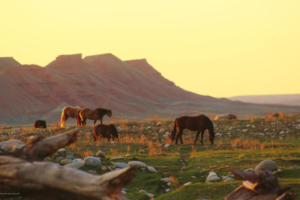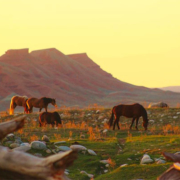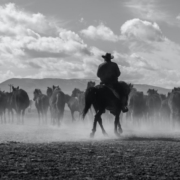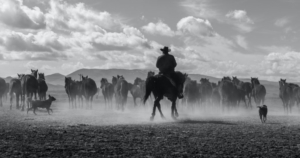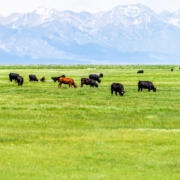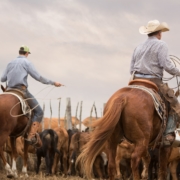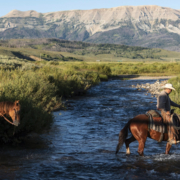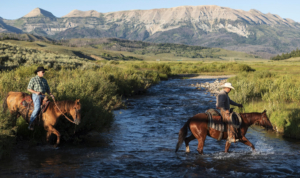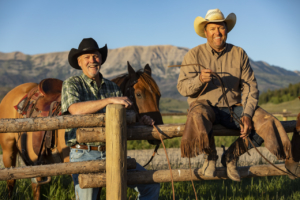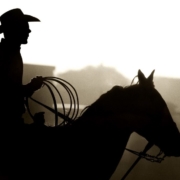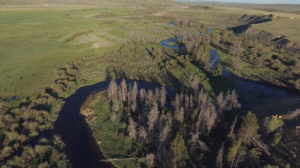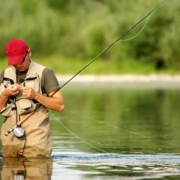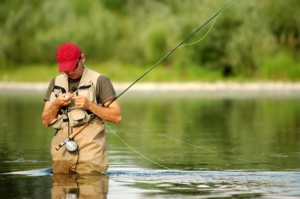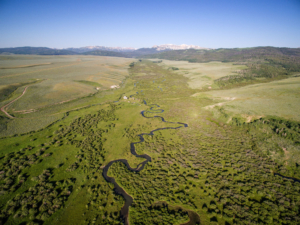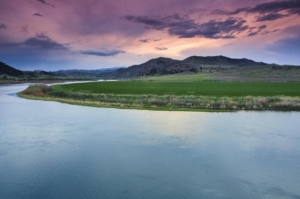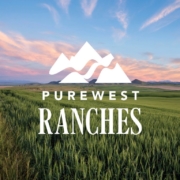Following negotiations of the Louisiana Purchase in 1803, American settlers began migrating westward. The acquisition from France, which President Jefferson would later say “stretched the Constitution until it cracked,” incorporated some 828,000 square miles of new territory, which boasted auspicious potential for those willing to brave the unknown.
Over the subsequent century, pioneers began pushing west in earnest, encouraged by reports from early expeditioners, who described vast and fertile lands beyond the Mississippi River. Many early settlers were met by impressive free-roaming herds of cattle and bison, particularly throughout Texas and Oklahoma, that had been domesticated, to varying degrees, by Native Americans and Mexican vaqueros.

The cattle, settlers soon realized, proved an unexpectedly lucrative business specimen. Texas cowboys – as they would come to be called when ranchers began large cattle drives that often spanned hundreds of miles – started rounding up herds, breeding them and flooding East Coast markets with a steady supply of beef. The burgeoning trade created a stable industry in a frontier rife with booms and busts.
Ranches in those early days were loosely defined. Built around affordable homestead plots issued by the government, pastures were often shared and cattle herds comingled to maximize the productivity of the land. That communality put a high importance on brands—and brand inspectors, range lawmen of sorts that enforced ownership and sought to stop rustlers. Regularly, cattlemen grazed stock on public lands, a practice that continues today, albeit under more formal federal and state regulation.
With only rudimentary cultivation practices and virtually no modern technologies, early cattle ranching generally required sizeable tracts of land to support even a modest herd. In the Rocky Mountain West, long winters required ranchers to manage both summer pastures and fields for raising hay to feed during the long winters. Many operations employed ranch hands, or “cow pokes,” responsible for moving cattle throughout the year, which involved the unenviable task of warding off predators.
Unwittingly, that style of ranching created a sustainability model that experts today herald as a solution to greenhouse emissions. By frequently moving herds, only briefly feeding on each spot, the cattle would not overrun the land. At the same time, their movement turned up the soil, allowing it to absorb more rain and minerals, and their manure naturally fertilized the ground.
The Development of Agribusiness
Through the early and mid-20th Century, as commercial and residential development restricted the land available to run cattle, and as conglomeration began to concentrate operations, a new model of ranching emerged: “macro-ag.” As imports and competition brought down beef prices, business-savvy ranchers soon realized the cattle business was a numbers game—larger, easily managed herds equated to greater profitability.
Rather than feeding an exclusive grass diet, which necessitated large amounts of land to support even a modest-sized herd, many ranchers switched to a combination of grain and high-protein hays like alfalfa. Unlike grass alone, those feeds put on weight and “finished,” or fattened, cattle for market in as little as nine months, compared to a year-and-a-half or more by free-range grazing. Grain diets, which developed markets for crop growers, could also be fed in concentrated feedlots, which needed much less space.
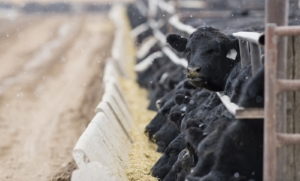
For decades the feedlot model dominated the beef industry, and smaller traditional ranchers were often forced out of the market by economies of scale and low prices, particularly in down years. The decline in competition created a snowball effect, producing fewer and larger mass-agriculture operations.
In tandem, awareness of greenhouse emissions began to gain greater public attention, which put the beef industry under intense scrutiny, which continues today. Cattle, by nature, emit a lot of carbon dioxide and methane—the latter of which has a significantly higher greenhouse effect than CO2. Experts estimate that cattle produce as much as 26 percent of the United States’ greenhouse gas emissions. Others put the figure around 14 percent.
The beef industry’s “carbon hoofprint” compelled many environmental activists to call on Americans to consume less red meat. And ranchers’ plight was not helped by popular conceptions of feedlots, which often invoked images of cattle packed into over-populated concrete corrals. As recently as 2018, studies have argued consumers should eat 90 percent less beef and 60 percent less milk to stave off effects of climate change.
But what’s old is new, and more recently – within the last quarter century – a new generation of ranchers is embracing old techniques to not only mitigate livestock’s greenhouse impacts, but potentially reverse climate trends. Regenerative ranching, evidence shows, helps capture carbon into the soil, offsetting emissions from cattle and actually producing a net-negative carbon output.
A Return to Tradition
Like early forms of ranching, regenerative agriculture relies on rotational, or “holistic planned” grazing, which involves shuffling herds from one plot of land to the next. More deliberate than those early days, cattle are kept on purposefully small tracts for short periods. That allows them to eat down the grass, but not overwhelm it, while simultaneously aerating and fertilizing the dirt, which stimulates growth once the herd is moved on.
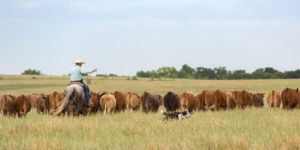
“Altering cattle grazing patterns and herd clustering to emulate those of their buffalo predecessors has a significant positive impact on the environment, including the health and diversity of the native grasses,” the Organic Consumers Association reported recently.
Many ranchers have discovered, too, the benefit of regularly replacing topsoil, or “range composting,” which, in addition to sequestering methane, helps maintain nutrient levels and foster growth. Healthy foliage, in turn, captures more carbon from the atmosphere, pulling gases out of the air. It also prevents erosion and runoff and better retains water, helping prevent against drought.
This process of regenerative ranching – which is hardly as economical as mass feedlots – has been buoyed by the modern food movement, which has put a heightened value on health, social and environmental accountability. In tandem with ranchers’ focus on ecological stewardship, a new generation of consumers has put a premium on knowing where and how their food was raised. And, increasingly, the public has gravitated towards grass-fed beef, which providers a healthier option to fattier grain-fed beef.
This combination of consumer and producer behaviors has begun to reshape and replace the former macro-ag model. Grass-fed beef commands only about a four percent market share of U.S. beef sales, according to a 2018 study by the Stone Barns Center for Food and Agriculture, but retail sales doubled year-over-year between 2012 and 2016, from $17 million to $272 million.
That’s given rise to smaller ranches, which for decades struggled to compete against corporate giants. It has even attracted unlikely allies, like presidential candidate and environmental activist Tom Steyer, who, with his wife Kat Taylor, founded the 1,800-acre TomKat Ranch in Pescadero, California.
“Think of the ranch as a huge science experiment,” Mr. Steyer told the New York Times in 2013. “Can you raise animals sustainably? Can the land become the carbon sink that it once was? Can you demonstrate a way of doing agriculture, raising food, that doesn’t damage the environment?”
“We would continue raising cattle even if no one ever ate another steak,” Taylor told the Los Angeles Times. She explains that the ranch’s model, and its cattle, could help reverse ecological changes that have contributed to climate change—and could upend agribusiness in the process.
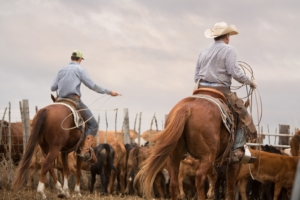
The cattle industry’s embrace of regenerative practices is helping pull along other agriculture, as well. Leveraging natural synergies among bovine, chicken, fish and a whole host of other species, innovators have begun to harness symbioses. Inka Biospheric Systems, the New York Times reports, is developing a fish and vegetable business on the Steyer ranch using barley fodder from crops and black soldier flies and earthworms attracted by manure.
The vermicompost byproduct Inka produces, the article adds, is used to fertilize stressed locations on the ranch and made into compost teas that can be spread on orchards and on livestock as a natural pesticide.
“What we are slowly doing is taking on the waste streams the ranch creates and converting those into assets,” says Brian Whitney, former chief executive of Inka.
Ranchers have long considered themselves stewards of the land. Like no other business, they rely on the health and productivity of the dirt under their feet to survive. Now, on the shoulder of innovative new practices and technologies, cattle ranching is gradually transitioning from an object of blame to a serious solution to climate change.
To learn more about cattle ranching and this remarkable region, contact our dedicated team.
*Article courtesy of Western Ranches, the ranch division of Jackson Hole Real Estate Associates.
